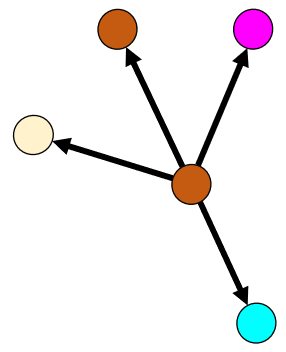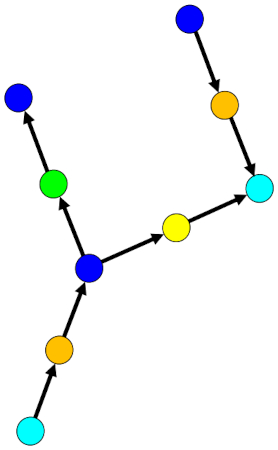Basic elements of networks
Description 
The network model for text interpretation is based on three main types of nodes and other less relevant nodes that play an auxiliary role.
The nodes are classified into the following types:
| Nodes | Meaning |
| Elements | Generally nouns referring to people, places, or objects. |
| Characteristics | Generally adjectives describing the elements. |
| Actions | Generally verbs representing relationships between elements. |
For the elements, three types have been introduced to facilitate querying. These are:
| | Objects or places in general. |
| | People identified by name or position. |
| | Person who writes or objects that belong to them. |
Regarding characteristics, the degree of subjectivity they possess is differentiated, establishing a scale from completely objective to subjective, defined as follows:
| | Objective. |
| | Rather objective. |
| | Neither objective nor subjective. |
| | Rather subjective. |
| | Subjective. |
Lastly, there are actions, which can have different levels of polarity, ranging from undesirable (negative) to desirable (positive). In this case, the following have been defined:
| | Undesirable. |
| | Rather undesirable. |
| | Neutral. |
| | Rather desirable. |
| | Desirable. |
ID:(31, 0)
Simplified model of the network
Description 
The foundation of the network model consists of two types of constellations. The first one is the descriptive part where elements are associated with their characteristics:

Element-Characteristics Model (EC): The element is represented in blue, while the other nodes represent characteristics and are shown in various colors based on their degree of subjectivity.
In these cases, the association is always made from the elements (typically nouns) to the characteristics (adjectives) (EC).
The second one is the part that describes the dynamics through actions between the elements:

Element-Action-Element Model (EAE): The elements are depicted in blue, and the other nodes, displayed in different colors, represent the actions.
In these cases, the association is always made from one element (typically a noun) via an action (typically a verb) to another element (again, typically a noun) (EAE).
The overall graph is the combination of these two types of constellations.
ID:(29, 0)
Examples element-characteristics (EC)
Description 
A simple example with one characteristic is:
which is composed of:
| The | apple | is | red | . |
| DET | NOUN | AUX | ADJ |
This can be represented by the graph:

which includes the table with the complete analysis.
In this case, we can see how the characteristic red is assigned to the element apple.
A second example with two characteristics is:
which is composed of:
| The | apple | is | sweet | and | juicy | . |
| DET | NOUN | AUX | ADJ | CCONJ | ADJ | . |
This can be represented by the graph:

which includes the table with the complete analysis.
A third example with three characteristics is:
which is composed of:
| The | apple | is | red | , | sweet | and | juicy | . |
| DET | NOUN | AUX | ADJ | ADJ | CCONJ | ADJ | . |
This can be represented by the graph:

which includes the table with the complete analysis.
In general, the diagram starts from the element towards the first adjective, and then the remaining adjectives are included in relation to the first one.
ID:(32, 0)
Element-Action-Element Examples (EAE)
Description 
A simple example with one action is:
It can be represented by the following graph:

The corresponding analysis table is as follows:
| John | eats | an | apple | . |
| PROPN | VERB | DET | NOUN |
In this case, we can observe how the element John is associated with the action eats, and the action, in turn, is associated with the element apple.
A second example with two actions is:
It can be represented by the following graph:

The corresponding analysis table is as follows:
| John | eats | an | apple | that | falls | from | the | tree | . |
| PROPN | VERB | DET | NOUN | PRON | VERB | ADP | NOUN |
In this case, we can observe how the element John is associated with the action eats, and the action, in turn, is associated with the element apple. Later, through the action falls, it is associated with the element tree.
In this case, the adverb from is crucial as it clarifies where it falls from. Without it, we would have 'apple falls tree,' which could mean either 'the apple falls from the tree' or 'the tree falls from the apple.'
A third example with three actions is:
It can be represented by the following graph:

The corresponding analysis table is as follows:
| John | eats | an | apple | that | falls | from | the | tree | . | He | likes | apples | . |
| PROPN | VERB | DET | NOUN | PRON | VERB | ADP | NOUN | ADP | PRON | VERB | NOUN |
In this case, we can observe how the element John is associated with the action eats, and the action, in turn, is associated with the element apple. Later, through the action falls, it is associated with the element tree. Finally, the relationship between the element John and the element apple is added through the action likes.
At this point, it is important to highlight that both sentences are related to John, even though the second one only refers to him using the pronoun he. Such associations are crucial to ensure that all references, including indirect ones, are captured, and the network correctly expresses all the information.
ID:(30, 0)
